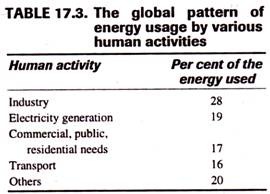renewable and non renewable energy sources
The energy resources that are replaced by natural processes are called renewable energy resources. These resources are, therefore, inexhaustible. Biomass (from plants), sunlight, streams of water, wind, tide, and draft animals (even humans) are examples of renewable sources of energy. In agricultural societies, most of the energy needs are fulfilled by wood, sunlight, streams of water, geothermal and even the muscle power of humans and draft animals.
But the sources of energy used by industrialized societies are quite different, e.g., mineral oil, coal, natural gas and even nuclear energy (Table 17.2). These energy resources are present on the earth in limited quantities.
As they are used up they become depleted to a point where it is no longer economically possible to use them; these energy resources are termed as non-renewable energy resources. Oil, coal and natural gas are known as fossil fuels since they are derived from the remains of protists and plants that were fossilized and compressed by the geological processes in the Earth’s crust.
The fossil fuels are the main sources of non-renewable energy, and nuclear energy provides only about 7% of the energy generated globally from non-renewable sources (Table 17.2). We have become so dependent on these fuels for our food, clothing, heating, industrial production and transportation (Table 17.3) that it is impossible to imagine our lives without them.
The use of non-renewable energy sources has been fuelled by industrial development, and industrialised nations derive 96% of their energy needs from non-renewable sources, while in the developing countries this figure is only around 57%.
It is postulated that our energy needs by about 2050 will increase by 100% of our present needs; this increase will mainly result from increase in population and the level of industrialization in the developing countries.
Our non-renewable sources of energy will not be able to meet this energy need, and we will have to find alternative and, preferably, renewable sources of energy to sustain our lifestyles, and even ourselves. In addition, the supply of fossil fuels is limited; according to an estimate, their availability will begin to decline by 2015.



